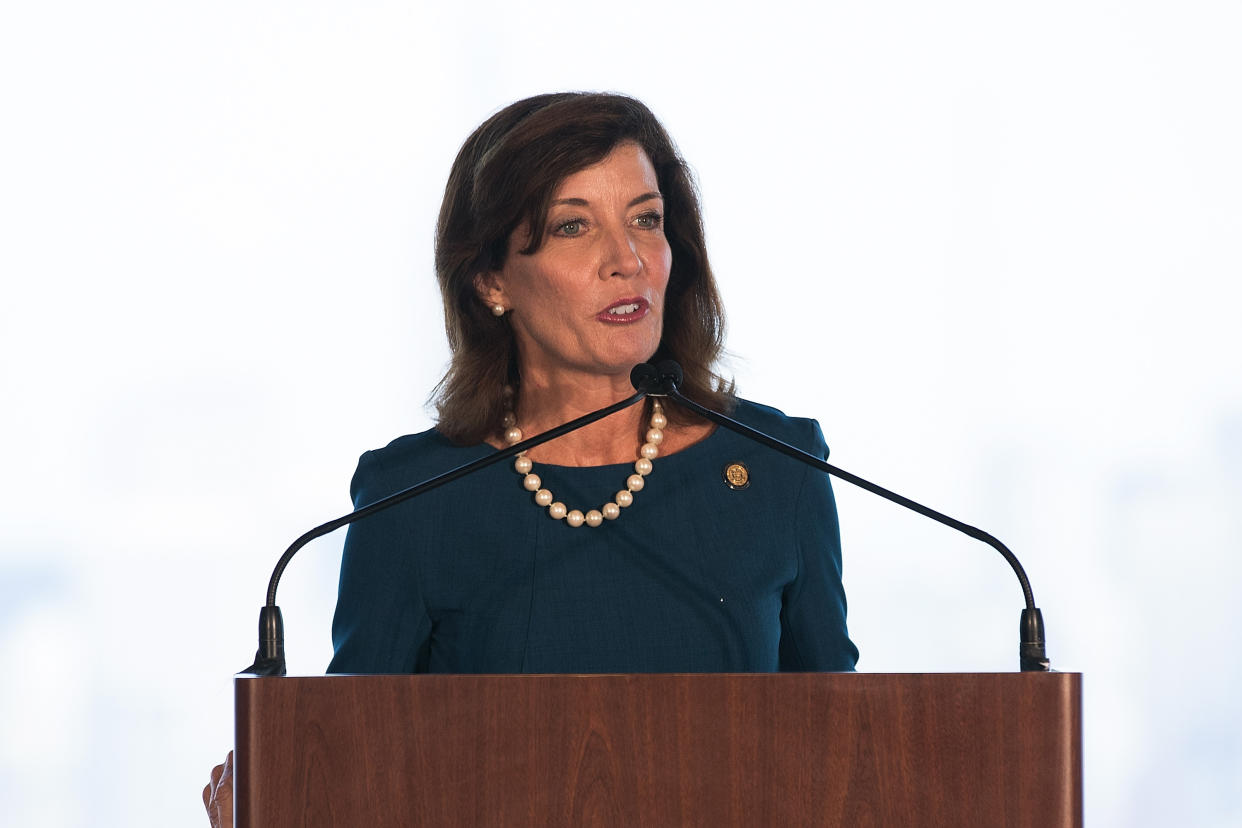NY Gov. Hochul approves new House map that could help Democrats; GOP says it will not sue

- Oops!Something went wrong.Please try again later.
Gov. Kathy Hochul on Wednesday granted final approval to a new congressional map for New York, after lawmakers approved district lines that could modestly advantage Democrats.
Although the changes could hurt Republicans in New York House races in the fall, the GOP said Wednesday that it would not sue over the map. Before the new map was unveiled this week, Republicans had fretted that Albany’s ruling Democrats might aggressively redraw district lines
The final adjustments, which barely touch the city but tilt some competitive districts in the suburbs and upstate to the left, were passed by lawmakers on Wednesday afternoon after a chaotic long-running extension of the 2022 redistricting process.
The state Senate passed the map by a 45-to-17 vote; the Assembly approved it by a vote of 115 to 33. Hochul, a Democrat, signed the map into law later in the day.
The Legislature’s move to redraw the map may cap a tortured redistricting process and set in place lines that could last through 2030.
As Democrats used the courts to reopen the redistricting process and then rejected a bipartisan panel’s suggested revisions, top Republicans said their rivals were engaged in a partisan power play to build a new map to their advantage. The GOP dangled a threat of a lawsuit.
But when the Democrats unveiled their own proposed House lines, they had much in common with the current borders.
Assemblyman Andy Goodell, the Republican minority leader pro tempore, said he was “very frustrated” by the process. But he acknowledged some Republicans would support the result.
“Notwithstanding the process, for which some of us are holding our nose, a lot of the districts — particularly upstate — weren’t changed at all,” Goodell said during debate in the Assembly on Wednesday.
Later in the day, the chair of the New York Republican Party, Edward Cox, issued a statement saying that the new map is “not materially different” from the map used in the midterms.
“As such, there is no need for further litigation,” Cox added.
Former Rep. John Faso, who has represented Republicans in court drama over the maps, said by phone that he believed the “threat of litigation” had dissuaded Democrats from drawing dramatically different lines.
Democrats decided not to draw liberal Brooklyn neighborhoods into the Staten Island district of Rep. Nicole Malliotakis, a Republican. Even the alterations to swing suburban districts were limited.
The district of Tom Suozzi, the Long Island Democrat who won a much-watched special election this month to replace former Rep. George Santos, gains Democratic territory. Rep. Brandon Williams, a Syracuse-area Republican, could face a tougher reelection in a bluer district. And the swing district of Rep. Pat Ryan, a Hudson Valley Democrat, might move a point or two bluer.
David Wasserman, an election expert with the Cook Political Report, characterized the map as a “mild to moderate gerrymander.”
More than 19 million New Yorkers would not see their districts change, said Kenneth Zebrowski, the Democrat who sponsored the bill for the map in his chamber. In debate in the Assembly on Wednesday, he maintained Democrats did not consider party registration in making their changes to district lines.
City lines were left essentially the same. But in one tweak, the district of Rep. Jamaal Bowman was shifted to include Co-Op City in the Bronx. Bowman, a progressive Bronx Democrat, has landed in a competitive primary fight this year with Westchester County’s executive, George Latimer. But it was not clear that the change would significantly influence the race.
Rep. Hakeem Jeffries of Brooklyn, who leads the Democrats in his chamber and could be lifted to the speakership if his party performs well in November, hailed the passage of the new map.
“This map reunites several communities of interest, reduces the number of counties, towns and villages that are split and promotes compact congressional districts,” Jeffries said in a statement.
Two months ago, Democrats won approval from the state’s top court, the Court of Appeals, to restart the redistricting process. The process then went to the bipartisan Independent Redistricting Commission, which presented lawmakers with a blueprint similar to the current map.
Democrats voted the commission’s plan down on Monday before drawing their own lines.
For many, the process has delivered a dose of déjà vu.
In 2022, the Democratic Party attempted to draw a map that dramatically advantaged their own party. The map would have given the Democratic Party an advantage in 22 of 26 New York House districts. Deep-blue sections of brownstone Brooklyn including Park Slope would have joined Malliotakis’ district.
But the plan ran aground at the Court of Appeals, which deemed the lines unlawfully partisan.
Ultimately, an independent expert in Pennsylvania crafted lines that were used in the midterm elections. Republicans had a strong showing statewide, flipping four House seats in New York, and Democrats maintained the map was at least partly to blame.
After the midterms, Democrats wound up with 15 of New York’s 26 House seats. Registered Democrats outnumber Republicans by more than 2 to 1 statewide, and the national Democratic Party has seen the state as fertile ground to pick up seats as it aims to win back the House in November.
By reopening the process, Democrats could find themselves in a slightly better position in 2024 House races. But some Democrats have wondered whether the slight modifications to the map were worth the expensive court battles that made them possible.
_________
